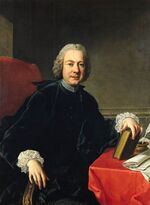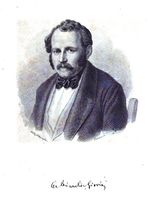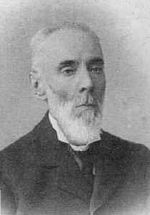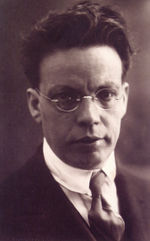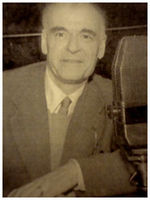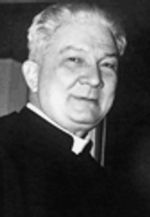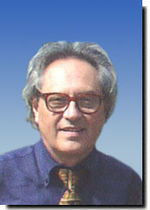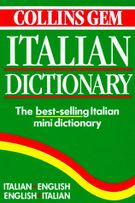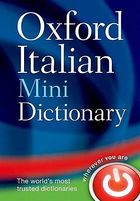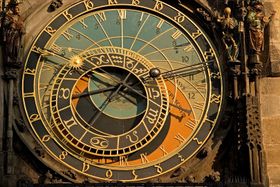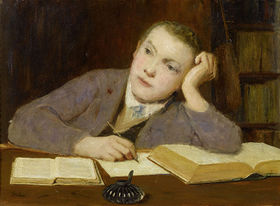Category:Historical Jesus Studies--Italian
|
The category: Historical Jesus Studies--Italian, includes scholarly and fictional works in Italian language dealing with Historical Jesus Studies.
HJS (Italian) -- History of research -- Overview
Since the Renaissance Italy had a long tradition of artistic and literary retellings of the life of Jesus, culminated in the masterpieces of Aretino and Metastasio and popularized in the 18th century by the production of numerous oratorios. No Italian scholar contributed to the international rise of modern critical research on the Historical Jesus, which was prompted by the publication in 1774-78 of the work of Hermann Samuel Reimarus. In the period preceding the Italian Unification, the Roman Catholic Church maintained a strict control of the cultural and religious life, effectively blocking the publication of any non-conformist voice. The most popular "Lives of Jesus" of early 19th-century Italy were literary works of spiritual edification, composed by Catholic prelates of great erudition, such as Antonio Cesari, and Giuseppe Lorini. Their scope did not go beyond the objective of providing a harmonization of the gospels to create elegant and consistent historical-biographical narratives. The news of the emerging scholarly debate on the Historical Jesus reached Italy as the echoes of far-away heresies. Beginnings of Critical Scholarship (second half of the 19th century)In the climate of religious conformism of the mid-19th century, the only conspicuous exception is given by historian Aurelio Bianchi-Giovini, who in 1853, challenging censorship and risking jail, made available to Italian readers the most advanced results of international research. His "Critica degli Evangeli" had to be published in Zurich, Switzerland and only in the 1860s, after the Unification, could be reissued in Milan. Bianchi-Giovini remained a brilliant, yet isolated figure of precursor in the field of Second Temple Judaism and Christian Origins. The establishment of the Italian State in 1861 created a new climate of religious freedom. A more solid beginning was provided by the translation of the works of David Friedrich Strauss and Ernest Renan in 1863. In a field hitherto monopolized by Catholic theologians and priests, the publication of such works was in itself a great accomplishment and as expected, was followed by a flow of scandalized judgments and apologetic responses by Catholic biblical scholars, notably, Alfonso Capecelatro, and Vito Fornari. Things were changing rapidly, however. Italy was now officially a liberal State which in 1870 successfully completed its battle against the temporal power of the Church and conquered Rome as its new capital. In 1873, following the abolition of the Faculties of Theology in Italy, the first chair of History of Christianity was established at the University of Naples. Liberal ideas penetrated also among Catholic authors. Luigi Arosio distinguished himself as the first Catholic NT scholar. In 1890, with his Life of Jesus illustrated by the Best Artists, Ruggeri Bonghi, a friend of Antonio Rosmini and Alessandro Manzoni, a professor of Latin literature and ancient history and founder in 1862 of the newspaper La Stampa, was the first author to inaugurate the Italian tradition of journalists and writers to compete successfully in this literary genre still largely reserved for ecclesiastical authors. The public was also exposed to the first romanticized "apocryphal" versions of the life of Jesus, being they characterized by a new and provocative look at ancient sources (the Judas of Petruccelli or the socialist Jesus of Giannelli) or instead animated by a reverent attitude toward the tradition (the Ben-Hur of Wallace, or The Centurion" by Routhier). In 1the 1890, Alessandro Chiappelli, professor f History of Philosophy at the University of Naples, published the first critical review of studies on the Historical Jesus in Italy. 1900sAt the turn of the century, Baldassarre Labanca, first professor of Church History at the University of Rome, was the beginner of the historical-critical study of religion in Italy, with his 1900 book on the reception of Renan. The works of Le Camus and Lacey were translated into Italian, even the Jesus Myth Theory made its appearance with Emilio Bossi. The growing influence of liberal Theology prompted the condemnation of Modernism by Pope Pius X in 1907. 1910sIn the 1910s it seemed that an Italian School could flourish in line with the approach of the European Liberal School, with the contributions by Baldassarre Labanca, Fleice Momigliano (the translator and editor of Claude Montefiore), and Giuseppe Chiminelli. The movie Christus, shot in the "original locations" by [{Giulio Antamoro]] in 1916, was an international success. 1920sIn 1920 the literary retelling of the Life of Jesus by Italian novelist Giovanni Papini was a sensation, being translated in all major languages. Catholic scholar Leone Tondelli and Ernesto Buonaiuti (now a University professor after his excommunication in 1925) produced some remarkable works. Yet, the rise of Fascism in the ‘20s and especially, the Concordat of 1929 between Fascist Italy and the Vatican, caused a progressive yet dramatic decline in the freedom of research and the end of this creative experience. Felice Momigliano died in 1924 (being haunted even in death by vicious anti-Semitic attacks), Ernesto Buonaiuti lost his academic position, and Luigi Salvatorelli published in English in the Harvard Theological Review his long essay on "The Historical Investigation of the Origins of Christianity" (1929). 1930sIn the 1930s the interest in the research on the Historical Jesus was kept alive by the translation of the works of a few French and German authors of proved orthodoxy, such as Emile Lagrange, Franz Michel Willam, and Louis-Claude Fillion. And yet Italy was still capable to produce some original contributions, by Leone Tonelli, Piero Martinetti, Igino Giordani, and Israel Zolli (who applied Jewish and rabbinic source to the study of the New Testament according to the lesson of Hermann Strack and Paul Billerbeck). The Fascist Racial Laws of 1938 were the last blow that denied any possibilities of survival to the first generation of Italian scholars on the Historical Jesus. 1940sDuring the war, there was only room for some pious retelling of the Life of Jesus, that could comfort and console. The Lives of Jesus by Giuseppe Ricciotti and Giacomo Mezzacasa played that role. No one of the old generation was left to rebuilt an Italian school on the Historical Jesus after the war. Giuseppe Ricciotti's Life of Jesus enjoyed a continuous success in Catholic circles, even in translation, but was a work that belonged to the past. In 1943 the Vatican had lifted the ban against the translation of the Bible in modern languages, and the Italian Biblical Association was established in 1948, but after decades of repression and persecution, the new generation was not made of trained scholars. Primo Mazzolari and Francesco Magri were social activists who drew inspiration from the life of Jesus for their political views. Salvatore Quasimodo, Riccardo Bacchelli, Piero Bargellini and Michele Saponaro were writers, novelists and poets. After the Holocaust and the shocking conversion of Israel Zolli (now Eugenio Zolli) to Catholicism, the Jewish voice could be heard only through the translation of Scholem Asch's novel on Jesus. 1950s1960sThe Second Vatican Council opened in 1962; it laid the foundations for a renewed interest in historical research and fostered a new climate of freedom and ecumenical dialogue. The impact on the study of the Historical Jesus was enormous, especially, for the rediscovery of the Jewishness of Jesus and of the social and political implications of his preaching. In 1964 Pier Paolo Pasolini's The Gospel according to Matthew, dedicate by the marxist author to the "loving memory of John XXIII," received international acclaim. 1970s The seminal work of Carlo Maria Martini, rector of the Pontifical Biblical institute in the 1970s, prepares the path for the emergence of a new generation of Italian scholars: 1980s In the 1980s an Italian school on the Historical Jesus finally reemerged. The generation of the Vatican II found its leaders in Giuseppe Barbaglio, Giorgio Jossa, and Rinaldo Fabris. 1990s In the 1990s Mauro Pesce emerged as the leading Italian scholar on the Historical Jesus working in Italian Universities. 2000s In 2003 Second Temple specialist Paolo Sacchi published his own specific contribution to the Historical Jesus, and Gabriele Boccaccini edited a volume on the development of early Christology, as the result of a meeting in Venice of Italian and international specialists, and a detailed essay on the history of the Historical Jesus Research in Italy in 2007. In 2006 the publication of Inchiesta su Gesu, in which Corrado Augias interviewed specialist Mauro Pesce generated a lot of controversy and showed the still fragile impact of historical research in the Italian society. 2010s Mauro Pesca and Giorgio Jossa remained the most active Italian scholars on the Historical Jesus. There are three major obstacles: the precarious situation of studies in religion in Italian Universities and Seminaries; the lasting influence of religious conservatism against the historical method; and the difficulty for young researchers and scholars to find academic positions. What will follow the generation of the Second Vatican Council is yet to be seen. References
|
Cognate Fields (Italian)
|
Pages in category "Historical Jesus Studies--Italian"
The following 200 pages are in this category, out of 304 total.
(previous page) (next page)1
- Scenes from the Life of Jesus (1150 Master of Palermo Palatine Chapel), art
- Scenes from the Life of Jesus (1320 Master of Sant'Abbondio), art
- Scenes from the Life of Jesus (1340 Memmi), art
- Vita di Cristo (Life of Christ / 1472 Cornazzano), poetry (Italian)
- == == 1500s == == ==
- L'umanità di Cristo (The Humanity of Christ / 1535 Aretino), novel
- Vita, passione, et resurretione di Iesu Christo Nostro Salvatore (Life, Passion and Resurrection of Jesus Christ Our Savior / 1544 Amulio), book
- Compendio historico del Vecchio, e del Nuovo Testamento (1586 Dionigi), book
- == == 1600s == == ==
- Vita di Giesu Christo figliuolo di Dio, et di Maria sempre Vergine (Life of Jesus Christ and Mary / 1625 Santarelli), book
- L'orto di Getsemani glorioso nei sudori di Cristo (1661 Arresti), oratorio
- Licenza di Giesù da Maria (1661 Arresti), oratorio
- La passione di Giesù Christo (1677 Cherici), oratorio
- Passio secundum Ioannem (St. John Passion / 1679 Scarlatti), oratorio
- Çeta e profetëve / L'infallibile verità della cattolica fede (The Bands of the Prophets / 1691 @1685 Bogdani), book (Albanian-Italian ed.)
- La passione di Cristo (The Passion of Christ / 1693 Ariosti / Arnoaldi), oratorio (music & libretto), Modena premiere
- == == 1700s == == ==
- La sepoltura di Cristo (1704 Predieri / Mazzoni), oratorio
- La resurrezione (The Resurrection / 1708 Haendel / Capece), oratorio (music & libretto), Rome premiere (cast)
- Cristo nell’orto (Christ in the Garden / 1718 Fux / Pariati), oratorio
- Il re del dolore (1722 Caldara / Pariati), oratorio
- Morte e sepoltura di Cristo (1724 Caldara / Fozio), oratorio
- Il testamento di nostro Signore Gesù Cristo sul Calvario (1726 Fux / Pariati), oratorio
- Trattenimento istorico teologico, e scritturale sopra i Santi Vangeli (Historical, Theological and Scriptural Treatise on the Holy Gospels / 1727 Calino), book
- La passione di Gesù Cristo (The Passion of Jesus Christ / 1730 Caldara / @1730 Metastasio), oratorio (music), Vienna premiere
- La passione di Gesù Cristo (The Passion of Jesus Christ / 1730 Metastasio), libretto (oratorio)
- La passione di Gesù Cristo (The Passion of Jesus Christ / 1733 Sodi / @1730 Metastasio), oratorio (music), Montefiascone premiere
- Gesù presentato nel Tempio (1735 Caldara / Zeno), oratorio
- La passione di Gesù Cristo (The Passion of Jesus Christ / 1735 Gregori / @1730 Metastasio), oratorio (music), Lucca premiere
- La passione di Gesù Cristo (The Passion of Jesus Christ / 1735 Venturelli / @1730 Metastasio), oratorio (music), Modena premiere
- La passione di Gesù Cristo (The Passion of Jesus Christ / 1737 Sarro / @1730 Metastasio), oratorio (music), Rome premiere
- La passione di Gesù Cristo (The Passion of Jesus Christ / 1739 Conti / @1730 Metastasio), oratorio (music), Naples premiere
- La passione di Gesù Cristo (The Passion of Jesus Christ / 1742 Perez / @1730 Metastasio), oratorio (music), Palermo premiere
- La passione di Gesù Cristo (The Passion of Jesus Christ / 1743 Basili / @1730 Metastasio), oratorio (music), Recanati premiere
- La passione di Nostro Signor Gesù Cristo (1745 Brunassi), play
- La Passione di Nostro Signore Gesù Cristo (1745 Sellitto), oratorio
- La passione di Gesù Cristo (The Passion of Jesus Christ / 1749 Cornaro / @1730 Metastasio), oratorio (music), Rome premiere
- La passione di Gesù Cristo (The Passion of Jesus Christ / 1749 Jommelli / @1730 Metastasio), oratorio (music), Rome premiere
- La passione di Gesù Cristo (The Passion of Jesus Christ / 1754 Holzbauer / @1730 Metastasio), oratorio (music), Mannheim premiere
- La Passione di Nostro Signor Gesù Cristo (1756 Feroci / Metastasio), oratorio
- Vita di nostro signore Gesù Cristo (Life of Our Lord Jesus Christ / 1761 Massini), book
- La passione di Gesù Cristo (The Passion of Jesus Christ / 1762 Vannucci / @1730 Metastasio), oratorio (music), Lucca premiere
- La passione di Gesù Cristo (The Passion of Jesus Christ / 1767 Naumann / @1730 Metastasio), oratorio (music), Padua premiere (cast)
- La passione di Gesù Cristo (The Passion of Jesus Christ / 1770 Kühl / @1730 Metastasio), oratorio (music), Hamburg premiere
- La passione di Gesù Cristo (The Passion of Jesus Christ / 1772 Sales / @1730 Metastasio), oratorio (music), Ehrenbreitstein premiere
- La passione di Gesù Cristo (1773 Myslivecek / Metastasio), oratorio
- La passione di Gesù Cristo (The Passion of Jesus Christ / 1773 Mysliveček / @1730 Metastasio), oratorio (music), Florence premiere
- La Passione di nostro Signore Gesù Cristo (The Passion of Jesus Christ / 1775 Crispi / @1730 Metastasio), oratorio (music), Rome premiere
- La passione di Gesù Cristo (The Passion of Jesus Christ / 1776 Luchesi / @1730 Metastasio), oratorio (music), Bonn premiere
- La passione di Gesù Cristo (The Passion of Jesus Christ / 1776 Uttini / @1730 Metastasio), oratorio (music), Stockholm premiere
- La Passione di nostro Signore Gesù Cristo (The Passion of Jesus Christ / 1777 Salieri / @1730 Metastasio), oratorio (music), Vienna premiere (cast)
- La passione di Gesù Cristo (The Passion of Jesus Christ / 1778 Schuster / @1730 Metastasio), oratorio (music), Dresden premiere
- La passione di Gesù Cristo (The Passion of Jesus Christ / 1778 Starzer / @1730 Metastasio), oratorio (music), Vienna premiere
- La passione di Gesù Cristo (The Passion of Jesus Christ / 1780 Majo / @1730 Metastasio), oratorio (music), Bologna premiere
- La passione di Gesù Cristo (The Passion of Jesus Christ / 1783 Paisiello / @1730 Metastasio), oratorio (music), St. Petersburg premiere
- La passione di Gesù Cristo (The Passion of Jesus Christ / 1784 Reichardt / @1730 Metastasio), oratorio (music), Berlin premiere (cast)
- La passione di Gesù Cristo (The Passion of Jesus Christ / 1786 Prati / @1730 Metastasio), oratorio (music), Florence premiere
- La passione di Gesù Cristo (The Passion of Jesus Christ / 1787 Torelli / @1730 Metastasio), oratorio (music), Bologna premiere
- La passione di Gesù Cristo (The Passion of Jesus Christ / 1787 Zingarelli / @1730 Metastasio), oratorio (music), Milan premiere
- La passione di Gesù Cristo (The Passion of Jesus Christ / 1788 Spontoni / @1730 Metastasio), oratorio (music), Bologna premiere
- La passione di Gesù Cristo (1789 Andreozzi), oratorio
- La passione di Gesù Cristo (The Passion of Jesus Christ / 1790 Guglielmi / @1730 Metastasio), oratorio (music), Madrid premiere
- La passione di Gesù Cristo (The Passion of Jesus Christ / 1792 Mattei / @1730 Metastasio), oratorio (music), Bologna premiere
- La passione di Gesù Cristo (The Passion of Jesus Christ / 1794 Mortellari / @1730 Metastasio), oratorio (music), London premiere
- La passione di Gesù Cristo (The Passion of Jesus Christ / 1799 Nicolini / @1730 Metastasio), oratorio (music), Naples premiere
- La passione di Gesù Cristo (1799 Nicolini), oratorio
- == == 1800s == == ==
- La passione di Gesù Cristo (The Passion of Jesus Christ / 1800 Caruso / @1783 Paisiello), Perugia production (oratorio)
- La resurrezione di Gesù Cristo (1804 Weigl), oratorio
- La passione di Gesù Cristo (The Passion of Jesus Christ / 1811 Morlacchi / @1730 Metastasio), oratorio (music), Dresden premiere
- Storia della vita di Gesù Cristo (1812 Pertusati) = Histoire de la vie de Jesus-Christ (History of the Life of Jesus Christ / 1786-88 Compans), book (Italian ed.)
- Gerusalemme distrutta (1812 Dusik), oratorio
- Vita di Gesù Cristo e della sua religione (Life of Jesus Christ and His Religion / 1817 Cesari), non-fiction
- Vita e dottrina di Gesù Cristo (1822 Stolberg / Antici), non-fiction (Italian ed.)
- Parafrasi dei quattro Evangeli posti in armonia (1831-39 Barcellona), book
- Le sette ultime parole di Nostro Signore Gesù Cristo (1838 Mercadante), oratorio
- Julian; or, Scenes in Judea (1841 Ware), novel
- Il perfetto leggendario; ovvero, Storia della vita di Gesù Cristo (History of the Life of Jesus Christ / 1847-50 Lorini), non-fiction
- == == 1850s == == ==
- Critica degli Evangeli (1853 Bianchi-Giovini), book)
- Vita di Gesù (1863 Renan / De Boni), book (Italian ed.)
- La vita di Gesù; o, Esame critico della sua storia = Das Leben Jesu: kritisch bearbeitet (The Life of Jesus: Critically Examined / 1863 @1835 Strauss), book (Italian ed.)
- Errori di Renan nella vita di Gesù (1864 Capecelatro), non-fiction
- La vita di Gesù Cristo (1868 Capecelatro), non-fiction
- Della vita di Gesù Cristo (1869-93 Fornari), non-fiction
- Il Vangelo spiegato, difeso, meditato = L'Évangile expliqué, défendu, médité (The Gospel Explained, Defended, Meditated / 1876-77 @1864-66 Dehaut / Villoresi), book (Italian ed.)
- Gesù Cristo: studi storici (Jesus Christ: Historical Studies / 1878 Arosio), book
- L'Evangelo; ossia, Vita di Gesù Cristo narrata dai quattro evangelisti (The Gospel; or, The Life of Jesus Christ Narrated by the Four Evangelists / 1884 Arosio), book
- Cristo alla festa di Purim (Christ at the Feast of Purim / 1887 Bovio), play (Italian)
- Vita di Gesù (Life of Jesus / 1890 Bonghi), non-fiction
- Gesù Cristo e i suoi recenti biografi (1891-92 Chiappelli), essay
- Ben-Hur; ossia, I giorni del messia = Ben-Hur: A Tale of the Christ (1895 @1880 Wallace / Galea), novel (Italian ed.)
- The Quiet King (1896 Mason), novel
- La passione di Cristo secondo S. Marco (1897 Perosi), oratorio
- La risurrezione di Cristo (1898 Perosi), oratorio
- I miracoli di Gesù Cristo (The Miracles of Jesus Christ / 1899 Arosio), book
- La passione di Cristo (The Passion of Christ / 1899 Calcina), short film
- Il natale del Redentore (1899 Perosi), oratorio
- == == 1900s == == ==
- Passione di Gesù (Passion of Jesus / 1900 Cristofari, Topi), short film
- La "Vita di Gesù" di Ernesto Renan in Italia: studio critico (1900 Labanca), book
- La vita di N. S. Gesù Cristo = La vie de N.S. Jésus-Christ (The Life of Christ / 1900 @1883 Le Camus / Gramatica), book (Italian ed.)
- L'entrata di Cristo in Gerusalemme (1900 Perosi), oratorio
- La strage degli innocenti (1900 Perosi), oratorio
- Gesù Cristo nella letteratura contemporanea straniera e italiana (1903 Labanca), book
- Gesù Cristo non è mai esistito (1904 Bossi), non-fiction
- Il Cristo alla festa di Purim (Christ at the Feast of Purim / 1904 Giannetti / Bovio), opera (music & libretto), Rio de Janeiro premiere
- La figura storica di Gesù (The Historical Figure of Jesus / 1904 Pandozi), book
- Il processo di Gesù (The Trial of Jesus / 1904 Rosadi), non-fiction
- Gesù Cristo, il suo tempo e la sua dottrina (1907-1908 Caraccio), book
- Il valore del titolo "Figlio di Dio" nella sua attribuzione a Gesù presso gli Evangeli Sinottici (1907 Cellini), book
- Il Nazareno (The Nazarene / 1907 Giannetti / Golisciani), opera (music & libretto), Rio de Janeiro premiere
- Il Cristo storico = The Historic Christ (1907 @1905 Lacey), non-fiction (Italian ed.)
- == == 1910s == == ==
- Gesù di Nazareth (1910 Labanca), book
- Gesù Cristo e i suoi moderni critici (1911 Ballerini), non-fiction
- Satana (Satan / 1912 Maggi), feature film
- Gesú e il mito di Cristo (Jesus and the Christ Myth / 1912 Puglisi), book
- Gesù di Nazareth nel pensiero ebraico contemporaneo = Some Elements in the Religious Teaching of Jesus according to the Synoptic Gospels (1913 @1910 Montefiore / Momigliano), book (Italian ed.)
- Le sette parole di N.S. Gesù Cristo sulla croce (1913 Perosi), oratorio
- La leggenda di Gesù = Kristuslegender (1914 @1904 Lagerlöf / Albertini), novel (Italian ed.)
- Vita di Gesù (Life of Jesus / 1916 Asioli), book
- Il Golgota (Golgotha / 1916 Consalvi), feature film
- Gesù di Nazareth: studio critico-storico (Jesus of Nazareth: A Critical-Historical Essay / 1918 Chiminelli), book
- Gesù Cristo: studio apologetico-religioso (Jesus Christ: An Apologetic-Religious Essay (1918-19 Oldrà), book
- == == 1920s == == ==
- Detti di Gesù (1922 Picherle), book
- La passione di Cristo (1923 Pea), play
- La passione di Cristo (1924 Colantuoni), play
- Gesù nella storia: al centro della critica biblica (1925 Tondelli), book
- Gesù il Cristo (1926 Buonaiuti), book
- Il mistero di Gesù = Le mystère de Jésus (The Mystery of Jesus / 1926 @1924 Couchoud / Treves), non-fiction (Italian ed.)
- Il primo evangelo (1928 Moccia), arch-fi
- == == 1930s == == ==
- L'Evangelo di Gesù Cristo = L'Évangile de Jésus-Christ (The Gospel of Jesus Christ / 1930 @1929 Lagrange / Gramatica), book (Italian ed.)
- Gesù sconosciuto = Иисус Неизвестный (Jesus the Unknown / 1933 @1932 Merezhkovsky / Poggioli), non-fiction (Italian ed.)
- La vita di Gesù nel paese e nel popolo d'Israele = Das Leben Jesu im Lande und Volke Israel (1935 @1933 Willam / Pastore), book (Italian ed.)
- Il Nazareno: studi di esegesi neotestamentaria alla luce dell’aramaico e del pensiero rabbinico (1933 Zolli), book
- Vita di N. S. Gesù Cristo = Vie de N.S. Jésus-Christ (1934 @1922 Fillion / Fiori), book (Italian ed.)
- Cristo e noi (Christ and Us / 1934 Tilgher), non-fiction
- Gesù Cristo: studi su le fonti, il pensiero e l’opera (1936 Tondelli), book
- Vita di Gesù = Vie de Jésus (1937 @1936 Mauriac / Novaro), novel (Italian ed.)
- == == 1940s == == ==
- Vita di Gesù Cristo (The Life of Christ / 1941 Ricciotti), book
- Vita di Gesù Cristo (Life of Jesus Christ / 1942 Mezzacasa), book
- Gesù secondo san Giovanni (1943 Tondelli), book
- Gesù Cristo: la sua vita, la sua dottrina, l'opera sua = Jésus-Christ: sa vie, sa doctrine, son oeuvre (1945 @1933 Prat / Pellizzari), book (Italian ed.)
- Il grande sogno (1946 Villa), novel
- Il Nazareno (1947 Asch), novel (Italian ed.)
- Lo sguardo di Gesù (1948 Bacchelli), novel
- Il processo di Gesù, "re dei Giudei" (The Trial of Jesus, "King of the Jews" / 1948 Nardi), non-fiction
- Il martire del Golgota (1948 Pérez Escrich), novel (Italian ed.)
- Gesù (Jesus / 1949 Saponaro), non-fiction
- == == 1950s == == ==
- Gesù (1950 Zini) = Jésus (Jesus / 1933 Guignebert), book (Italian ed.)
- Il nazareno (1950 Perosi), oratorio
- Il processo di Cristo (1950 Porrino / Ricciotti), oratorio
- La leggenda di Gesù (The Jesus Legend / 1950 Souvarine), non-fiction
- Gesú nella piú antica tradizione cristiana (1954 Subilia), book
- Processo a Gesù (Trial of Jesus / 1955 Fabbri), play
- Il figlio dell'uomo (The Son of Man / 1955 Sabel), feature film
- Il poema dell'uomo-Dio (1956-1959 Valtorta), vision
- Il giorno in cui Cristo morì = The Day Christ Died (1958 Bishop / Satta), novel (Italian ed.)
- Gesù e Paolo identificati nella storia profana (Jesus and Paul Identified in Secular History / 1958 Turone), book
- == == 1960s == == ==
- The Man Born to Be King (1961 CBC), TV film
- Gesù nel suo tempo = Jésus en son temps (1962 @1944 Daniel-Rops / Degli Occhi), book (Italian ed.)
- Gli anni oscuri di Gesù = Les années obscures de Jésus (1963 @1960 Aron / Miniussi), non-fiction (Italian ed.)
- Processo a Gesù (Trial of Jesus / 1963 Bolchi), TV film
- Il problema del Gesù storico = Das Problem des historischen Jesus (The Problem of the Historical Jesus / 1964 Jeremias / Pellizzari), book (Italian ed.)
- Gli Agrapha di Gesù = Unbekannte Jesusworte, 3rd ed. (Unknown Sayings of Jesus / 1965 @1963 @1948 Jeremias / Soffritti), book (Italian ed.)
- Il sale della terra (1965 Monterosso), novel
- La vita di Gesù (The Life of Jesus / 1966 Craveri), non-fiction
- Processo a Gesù (Trial of Jesus / 1968 Bettetini), TV film
- Gesù di Nazareth = Jesus of Nazareth (1968 Bornkamm / Paschetto), book (Italian ed.)
- Seduto alla sua destra (Black Jesus / 1968 Zurlini), feature film
- == == 1970s == == ==
- Il maestro (1970 Brod / Bonfatti), novel (Italian ed.)
- Cristologia del Nuovo Testamento = Christology of the New Testament (1970 Cullmann / Rava), book (Italian ed.)
- Le parabole del regno = The Parables of the Kingdom (1970 @1961 Dodd / Ronchi), book (Italian ed.)
- Gesù e i rivoluzionari del suo tempo (1971 Cullmann / Stella), book (Italian ed.)
- Rabbi (1971 Nocentini), novel
- Cominciò con Gesù di Nazareth: il problema del Gesù storico = The Historical Jesus (1972 Zahrnt / Bonora), book (Italian ed.)
- Dai Vangeli al Gesù storico = De los Evangelios al Jesús histórico (From the Gospels to the Historical Jesus / 1974 @1971 Caba), book (Italian ed.)
- Gesù, la storia di un vivente = Jezus: het verhaal van een levende (Jesus: An Experiment in Christology / 1974 Schillebeeckx / Kortenaar), book (Italian ed.)
- (+) Il quinto evangelio (The Fifth Gospel / 1975 Pomilio), novel
- Jesus (1976 Flusser), book (Italian ed.)
- Gesù e Israele (1976 Isaac), book (Italian ed.)
- Ipotesi su Gesù (Jesus Hypotheses / 1976 Messori), non-fiction
- Kerygma e Gesù storico = Kerygma und historischer Jesus (A New Quest of the Historical Jesus / 1977 @1960 Robinson / Torti), book (Italian ed.)
- Conoscenza storica di Gesù (1978 Barbaglio), book
- == == 1980s == == ==
- Gesù e i movimenti di liberazione della Palestina (1980 Jossa), book
- Miracoloni (Big Miracles / 1981 Massaro), feature film
- Gesù e la storia (1981 Perrot) = Jésus et l'histoire (1979 Perrot), book (Italian ed.)
- Il Santo Graal = Holy Blood, Holy Grail (1982 @1982 Baigent, Leigh, Lincoln / Rambelli), arch-fi (Italian ed.)
- Indagine sulla crocefissione = Inquiry on the Crucifixion (1982 Parazzoli), non-fiction
- Gesù l'ebreo = Jesus the Jew (1983 @1973 Vermès / Grossi, Peretto), book (Italian ed.)
Media in category "Historical Jesus Studies--Italian"
The following 24 files are in this category, out of 24 total.
- 1904 Rosadi.jpg 800 × 1,231; 58 KB
- 1916 Antamoro (film).jpg 1,382 × 1,761; 278 KB
- 1921 * Papini (novel).jpg 333 × 499; 25 KB
- 1948 Nardi.jpg 375 × 500; 34 KB
- 1954 Fabbri.jpg 425 × 600; 145 KB
- 1959 Martini.jpg 223 × 300; 11 KB
- 1964 Pasolini (film).jpg 231 × 325; 16 KB
- 1975 Rossellini (film).jpg 166 × 255; 53 KB
- 1977 * Zeffirelli (TV miniseries).jpg 263 × 475; 43 KB
- 1982 Ghiberti.jpg 329 × 499; 14 KB
- 1986 Damiani (film).jpg 284 × 398; 33 KB
- 1987 Rossi (TV miniseries).jpg 200 × 280; 19 KB
- 1998 D'Alatri (film).jpg 348 × 488; 25 KB
- 2006 * Augias Pesce.jpg 320 × 500; 22 KB
- 2010 Chiesa (film).jpg 472 × 669; 146 KB
- 2013 Walt.jpg 333 × 499; 14 KB
- 2015 Nicolotti (book).jpg 341 × 522; 34 KB
- 2020 Virgili.jpg 167 × 266; 7 KB
- 2021 Penna.jpg 345 × 499; 52 KB
- 2021 Destro Pesce.jpg 341 × 499; 30 KB
- 2021 Jossa 2.jpg 337 × 499; 26 KB
- 2021 Jossa.jpg 321 × 499; 12 KB
- 2021-T Bermejo Rubio.jpg 319 × 500; 32 KB
- 2022 Virgili.jpg 348 × 499; 28 KB


